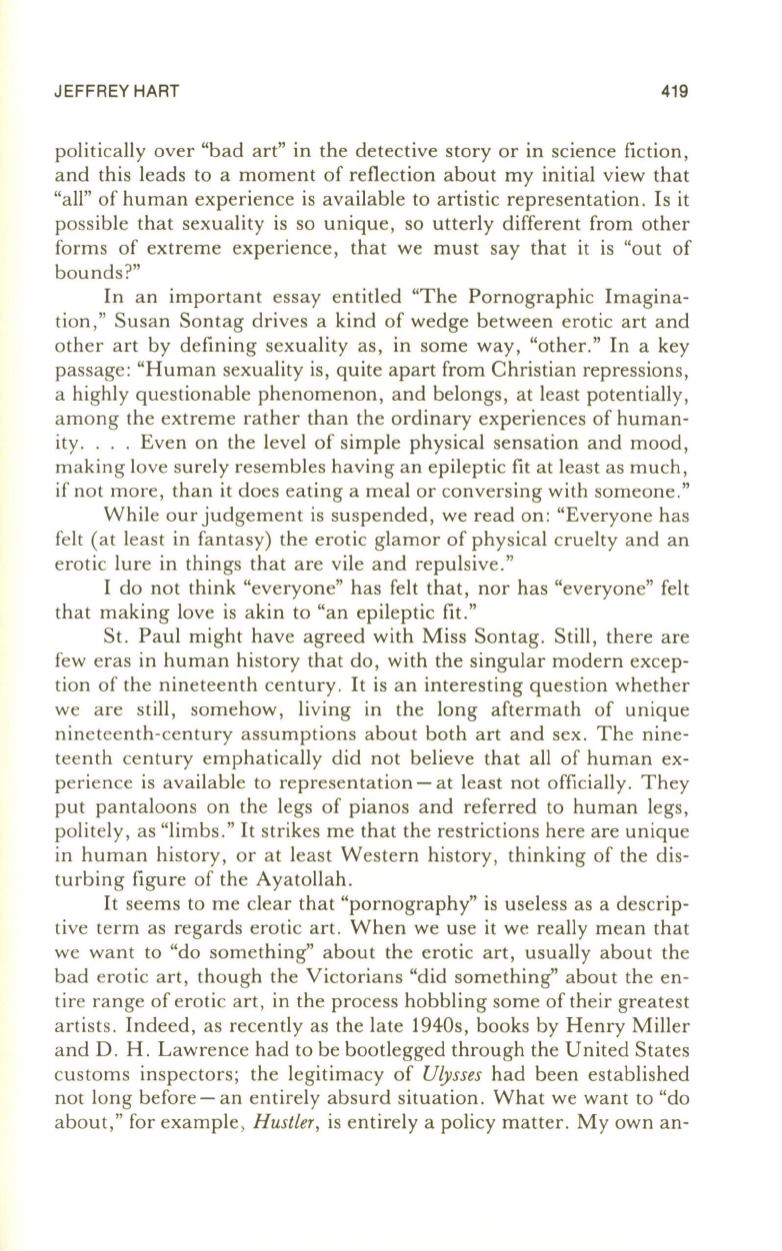
JEFFREY
HART
419
politically over "bad art" in the detective story or in science fiction,
and this leads to a moment of reflection about my initial view that
"all" of human experience is available to artistic representation. Is it
possible that sexuality is so unique, so utterly different from other
forms of extreme experience, that we must say that it is "out of
bounds?"
In an important essay entitled "The Pornographic Imagina–
tion," Susan Sontag drives a kind of wedge between erotic art and
other art by defining sexuality as, in some way, "other." In a key
passage: "Human sexuality is, quite apart from Christian repressions,
a highly questionable phenomenon, and belongs, at least potentially,
among the extreme rather than the ordinary experiences of human–
ity.... Even on the level of simple physical sensation and mood,
making love surely resembles having an epileptic fit at least as much,
if not more, than it does eating a meal or conversing with someone."
While our judgement is suspended, we read on: "Everyone has
felt (at least in fantasy) the erotic glamor of physical cruelty and an
erotic lure in things that are vile and repulsive ."
I do not think "everyone" has felt that, nor has "everyone" felt
that making love is akin to "an epileptic fit."
St. Paul might have agreed with Miss Sontag. Still, there are
few eras in human history that do, with the singular modern excep–
tion of the nineteenth century.
It
is an interesting question whether
we are still, somehow, living in the long aftermath of unique
nineteenth-century assumptions about both art and sex. The nine–
teenth century emphatically did not believe that all of human ex–
perience is available to representation - at least not officially. They
put pantaloons on the legs of pianos and referred to human legs,
politely, as "limbs ." It strikes me that the restrictions here are unique
in human history, or at least Western history, thinking of the dis–
turbing figure of the Ayatollah.
It seems to me clear that "pornography" is useless as a descrip–
tive term as regards erotic art. When we use it we really mean that
we want to "do something" about the erotic art, usually about the
bad erotic art, though the Victorians "did something" about the en–
tire range of erotic art, in the process hobbling some of their greatest
artists. Indeed, as recently as the late 1940s, books by Henry Miller
and D. H. Lawrence had to be bootlegged through the United States
customs inspectors; the legitimacy of
Ulysses
had been established
not long before - an entirely absurd situation. What we want
to
"do
about," for example ,
Hustler,
is entirely a policy matter. My own an-


